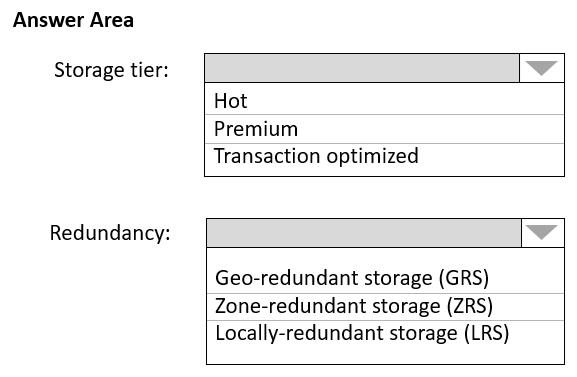HOTSPOT (Drag and Drop is not supported)
You plan to create an Azure Storage account that will host file shares. The shares will be accessed from on-premises applications that are transaction intensive.
You need to recommend a solution to minimize latency when accessing the file shares. The solution must provide the highest-level of resiliency for the selected storage tier.
What should you include in the recommendation? To answer, select the appropriate options in the answer area.
NOTE: Each correct selection is worth one point.
Hot Area:

- See Explanation section for answer.
Answer(s): A
Explanation:

Box 1: Premium
Premium: Premium file shares are backed by solid-state drives (SSDs) and provide consistent high performance and low latency, within single-digit milliseconds for most IO operations, for IO-intensive workloads.
Incorrect Answers:
- Hot: Hot file shares offer storage optimized for general purpose file sharing scenarios such as team shares. Hot file shares are offered on the standard storage hardware backed by HDDs.
- Transaction optimized: Transaction optimized file shares enable transaction heavy workloads that don't need the latency offered by premium file shares.
Transaction optimized file shares are offered on the standard storage hardware backed by hard disk drives (HDDs). Transaction optimized has historically been called "standard", however this refers to the storage media type rather than the tier itself (the hot and cool are also "standard" tiers, because they are on standard storage hardware).
Box 2: Zone-redundant storage (ZRS):
Premium Azure file shares only support LRS and ZRS.
Zone-redundant storage (ZRS): With ZRS, three copies of each file stored, however these copies are physically isolated in three distinct storage clusters in different Azure availability zones.
Reference:
https://docs.microsoft.com/en-us/azure/storage/files/storage-files-planning